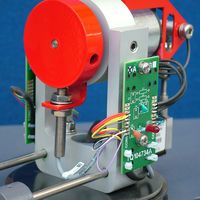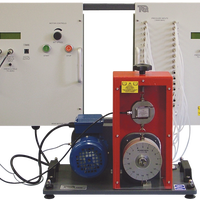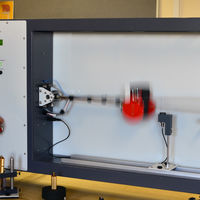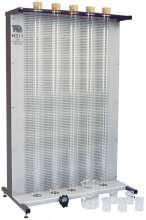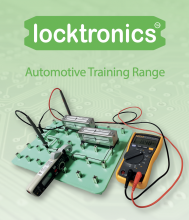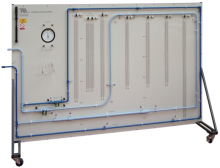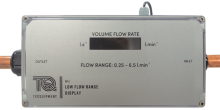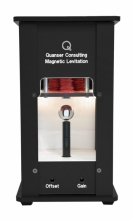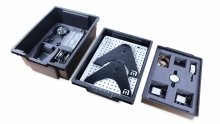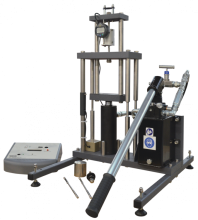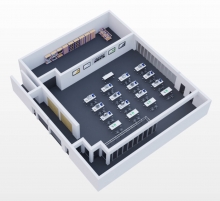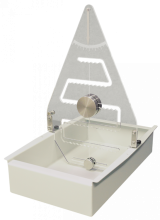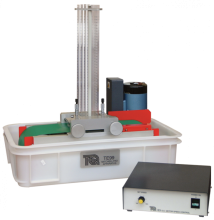A self-contained bench mounting apparatus for studies into the settling characteristics of suspended solids and the display of wall effects.
Process Control Training Systems
TecQuipment's process control range offers an extensive range of teaching equipment, from bench-top equipment for demonstrating process control principles, to products using industrial components for realistic vocational training.
The range provides users with the ability to study PID and programmable logic controllers and process control, both in isolation and in a systems setting. Students can learn about the control of flow, level, temperature, and pressure.
Engineering Lab Equipment for Teaching Solar Energy Principles
TecQuipment's solar energy equipment offers teaching tools for the core principles of solar energy, such as photovoltaic cells, flat plate solar thermal energy collectors, and focusing solar energy collectors. Students will learn the efficiencies and limitations of each method of harnessing and converting solar energy for use in the real world.
Engineering Lab Equipment for Detailed Studies of Static Equilibrium
The statics fundamentals product range provides tools for teaching the core principles essential in civil and mechanical engineering careers. The range demonstrates theories including concurrent and non-concurrent coplanar forces, Bow's notation, equilibrium theory, parabola theory, and more to life. The equipment consists of a series of modular experiment modules that fit to the essential base unit (Statics Work Panel), which can be mixed and matched to suit educational requirements.
Engineering Lab Equipment for Teaching Basic Structural Principles
The TecQuipment's Next Generation structures range consists of teaching equipment for understanding basic structural principles focusing on beams, bridges and cantilevers for students of mechanical, civil and structural engineering.
The USB interface hub, included with the Structures Platform (STS1) means this entire range of 21 experiments has VDAS Onboard, and directly connects to a computer running VDAS software that is available to download free here.
Arches, Bridges
& TrussesDeflections & StressFailureMomentsStructures Test
FrameTorsion
Teaching Equipment for Fundamental and Applied Thermodynamics
The engineering teaching equipment from TecQuipment's thermodynamic range illustrates the basic principles of thermodynamics through to complex theories. Students can learn using practical experiments about the behavior of gases, heat transfer and thermal conductivity, conduction, convection, and heat exchange. They can get hands-on to prove theories such as the Antoine equation, Seebeck effect, Lenz and Thomson effects, Carnot cycle and reversible Carnot cycle, Stefan Boltzmann law, Kirchhoff's law, and Lambert's direction law.
ThermodynamicsCompressorsHeat TransferPrinciplesSteamTemperature
Specialist Data Acquisition for TecQuipment Education Equipment
TecQuipment's in-house developed software, VDAS® (Versatile Data Acquisition System) has been tailored to operate in perfect harmony with the TecQuipment products to maximize learning potential.
The digital system is easy to set-up and use with simple USB connections. It provides real-time data-capture, calculation, charting, and data export. In some cases, real-time traces of analog signals and advanced signal processing are possible.
The hardware is available to purchase as a bench mounted unit, which can service many benchtop pieces of VDAS®-compliant equipment in a laboratory. It also comes as a frame-mounted unit designed to work with larger pieces of equipment. Increasingly, TecQuipment products have VDAS® included as an integral part of the equipment requiring only a suitable PC (no extra hardware). The latest software is always available to download free of charge to any user from the 'downloads' section of the website.
VDAS consists of both hardware and software.
VDAS Hardware
The hardware comes in three different options.
- VDAS On Board
The hardware is integrated into the teaching product as standard and requires no additional hardware to be purchased. All products with a ‘V’ at the end of the product code have VDAS On Board eg EC1501V. - VDAS Bench Mounted
The hardware is a separately purchased unit that sits on a bench that can serve many bench-top pieces of VDAS®-compliant equipment in a laboratory. - VDAS Frame Mounted
The hardware is a separately purchased frame-mounted unit designed to work with larger pieces of equipment.
VDAS Software
Software is available to download free of charge for an unlimited number of users from the 'downloads' section of the website. Visit the TecQuipment YouTube channel for videos on how to set up a connection, save and export results, and record data.
VDAS e-lab Software
For remote blended learning, TecQuipment offers VDAS e-lab software, which is flexible and easy to use cloud-based system enabling remote students to interactively engage and participate in laboratory experiments. Learn more about the annual licenses available by clicking here.
LabVIEW
LabVIEW Virtual Instruments are also available which display data from connected VDAS® compatible products. The results can be developed further by students using LabVIEW software.
A supersonic wind tunnel is a wind tunnel that produces supersonic speeds (1.2Mach number and flow are determined by the nozzle geometry. The Reynolds number is varied by changing the density level (pressure in the settling chamber). Therefore, a high-pressure ratio is required (for a supersonic regime at M=4, this ratio is of the order of 10). Apart from that, condensation of moisture or even gas liquefaction can occur if the static temperature becomes cold enough. This means that a supersonic wind tunnel usually needs a drying or a pre-heating facility. A supersonic wind tunnel has a large power demand, so most are designed for intermittent instead of continuous operation.
Pages
-
Item Number:H311 - Experiment
-
The Locktronics automotive range has been designed to meet the requirements of automotive engineering course standards set by the IMI, City & Guilds, and BTEC. The range is split into three levels, basic, intermediate and advanced and is ideal for automotive technicians to gain a good understanding of electrics, circuits and circuit fault finding, moving through to more complex solutions for an understanding of ECUs and CAN bus in vehicles.
-
Item Number:H16 - Experiment
An apparatus to allow students to investigate the friction losses in piping systems. The large open format of the apparatus makes it ideal for students working in small or large groups.
-
Item Number:H1L - ANCILLARY
The new Low Flow Range Display is an ancillary for measuring low flow rates of water, with low-level flow rates that the Hydraulic Bench cannot accommodate. This is particularly useful for experiments like those outlined in the Fluid Friction Apparatus that require the measurement of lower flow rates.
-
The Quanser Magnetic Levitation device is a single degree of freedom electromagnet-based system that allows users to levitate a ball vertically up and down. The overhead electromagnet generates an attractive force on the metal ball that initially sits on the post. The position of the ball is measured using a photo-sensitive sensor embedded inside the post. The system also includes a current sensor to measure the current inside the electromagnet’s coil.
-
Item Number:FM1292
This kit enables students to study materials fundamentals using a tensile tester, shear force tester and other equipment. This kit is supplied in storable trays and with a full, free curriculum workbook
-
Item Number:MF40 MKII - Experiment
A small bench-mounting hydraulic tensile testing machine/hardness tester with electronic digital readouts and digital data capture.
-
The Matrix Lab is a multi-disciplinary, multi-use, and multi-purpose teaching area. We can provide teaching solutions for many engineering disciplines. All of the equipment was designed and produced for a small footprint, low voltage, and easily storable.
-
Item Number:H2 MKII - Experiment
A bench mounting apparatus to determine the stability of a pontoon with its centre of gravity metacentric height and metacentre at various heights.
-
Item Number:TE99 - Experiment
A bench mounted, self contained apparatus to demonstrate the pressure distribution across the film of oil in a Michell tilting pad slider bearing. Helps to prove Reynold's equation for pressure gradient in fluid film.

